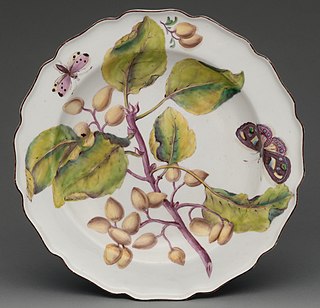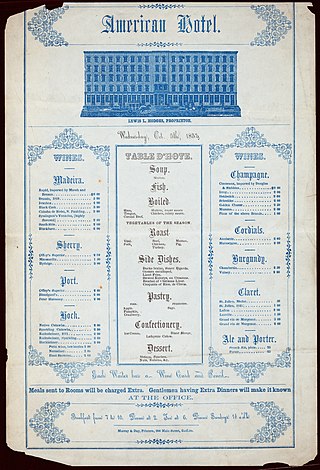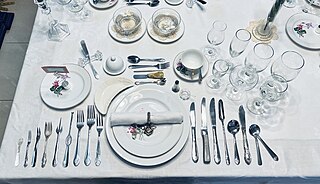
Charger plates or service plates are large plates used at full-course dinners and/or to dress up special events like parties and weddings. Charger plates have been in use since the 19th century.[ citation needed ]

Charger plates or service plates are large plates used at full-course dinners and/or to dress up special events like parties and weddings. Charger plates have been in use since the 19th century.[ citation needed ]
Food is not actually served on chargers; they are often called underplates or chop plates. [1] The word "charger" originated around 1275–1325 from the Middle English "chargeour". Formerly, a charger signified either a large platter or a large, shallow dish for liquids. [2]
They are usually larger than most common dinner plates. Since they are not used for food, charger plates can be found in a variety of materials, from traditional china to metal, wood, glass, plastic, and pearl, and they may be decorated with substances that can be toxic if ingested.
Charger plate etiquette and use vary. Some professional catering companies remove the decorative charger plate as soon as the guests are seated. In other instances, when the design of charger plates complements the design of dining plates, charger plates are left on the table throughout the course of the meal. Charger plates are always removed before serving desserts. [1]
In service à la russe , charger plates are called service plates and are kept on the table during the initial courses. Service plates thus act as a base for soup bowls and salad plates. After the soup course is finished, both the soup bowl and service plate are removed from the table; a heated plate is put in their place. The fish and meat courses are served from platters. (This was not the case historically, nor is it often followed in restaurants.) Directly before dessert, everything is removed from the place settings except the wine and water glasses and crumbs are cleared. The rule is as such: a filled plate is always replaced with an empty one, and no place goes without a plate until just before the dessert course.
In Mark 6:25, KJV, and Matthew 14:8, KJV, the "daughter of Herodias" requested John the Baptist's head in a “charger” from Herod Antipas as her reward for dancing at his birthday party. It was the subject of a painting by artist Andrea Solari. [3] [4] [5]
The following outline is provided as an overview of and topical guide to meals:

Thali or Bhojanam is a round platter used to serve food in South Asia, Southeast Asia and the Caribbean. Thali is also used to refer to an Indian-style meal made up of a selection of various dishes which are served on a platter. Thali is also used in south Asia for ceremonial purposes.

Table setting or place setting refers to the way to set a table with tableware—such as eating utensils and for serving and eating. The arrangement for a single diner is called a place setting. It is also the layout in which the utensils and ornaments are positioned. The practice of dictating the precise arrangement of tableware has varied across cultures and historical periods.

Service à la française is the practice of serving various dishes of a meal at the same time, with the diners helping themselves from the serving dishes. That contrasts to service à la russe in which dishes are brought to the table sequentially and served individually, portioned by servants.

A buffet can be either a sideboard or a system of serving meals in which food is placed in a public area where the diners serve themselves. A form of service à la française, buffets are offered at various places including hotels, restaurants, and many social events. Buffet restaurants normally offer all-you-can-eat food for a set price, but some measure prices by weight or by number of dishes. Buffets usually have some or mostly hot dishes, so the term cold buffet has been developed to describe formats lacking hot food. Hot or cold buffets usually involve dishware and utensils, but a finger buffet is an array of foods that are designed to be small and easily consumed only by hand, such as cupcakes, slices of pizza, foods on cocktail sticks, etc.

Tableware items are the dishware and utensils used for setting a table, serving food, and dining. The term includes cutlery, glassware, serving dishes, serving utensils, and other items used for practical as well as decorative purposes. The quality, nature, variety and number of objects varies according to culture, religion, number of diners, cuisine and occasion. For example, Middle Eastern, Indian or Polynesian food culture and cuisine sometimes limits tableware to serving dishes, using bread or leaves as individual plates, and not infrequently without use of cutlery. Special occasions are usually reflected in higher quality tableware.

A plate is a broad, mainly flat vessel on which food can be served. A plate can also be used for ceremonial or decorative purposes. Most plates are circular, but they may be any shape, or made of any water-resistant material. Generally plates are raised round the edges, either by a curving up, or a wider lip or raised portion. Vessels with no lip, especially if they have a more rounded profile, are likely to be considered as bowls or dishes, as are very large vessels with a plate shape. Plates are dishware, and tableware. Plates in wood, pottery and metal go back into antiquity in many cultures.

In restaurant terminology, a table d'hôte menu is a menu where multi-course meals with only a few choices are charged at a fixed total price. Such a menu may be called prix fixe. The terms set meal and set menu are also used.

A full-course dinner is a meal with multiple courses, almost invariably eaten in the evening or afternoon. Most Western-world multicourse meals follow a standard sequence, influenced by traditional French haute cuisine. It commonly begins with an appetizer, followed by the main course, the salad course, and eventually the dessert, but the exact sequence varies widely. Full-course dinners are generally very formal as well as very expensive, and can have as few as 3 or as many as 21 courses. Some major styles include service à la russe and service à la française.
Silver service is a method of food service at the table, with the waiter transferring food from a serving dish to the guest's plate, always from the left. It is performed by a waiter using service forks and spoons from the diner's left. In France, it appears to be now known as service à l'anglaise, although historically that meant something else, with the hostess serving out the soup at one end of the table, and later the host carving a joint of meat at the other end, and diners serving themselves with other dishes present.

Table manners are the rules of etiquette used while eating, which may also include the use of utensils. Different cultures observe different rules for table manners. Each family or group sets its own standards for how strictly these rules are to be followed.
The historical form of service à la russe is a manner of dining with courses brought to the table sequentially, and the food portioned on individual plates by the waiter. It contrasts with the older service à la française, based on several courses brought to the table simultaneously, in an impressive display of tureens and serving dishes, with diners plating food themselves.
Restaurants fall into several industry classifications, based upon menu style, preparation methods and pricing, as well as the means by which the food is served to the customer. This article mainly describes the situation in the US, while categorisation differs widely around the world.

A finger bowl is a bowl of water that dinner guests use for rinsing their fingers. In a formal meal, the finger bowl is brought to the table at the time of the dessert course of the meal, and guests set it aside for use after the last course, just before leaving the table. In less formal service, the finger bowl may be presented after any course that involves finger food and may even be presented after more than one such course in a single meal.
Lunch is a meal eaten around the middle of the day. It is commonly the second meal of the day, after breakfast, and varies in size by culture and region.

Smörgåsbord is a buffet-style meal of Swedish origin. It is served with various hot and mainly cold dishes.

Food presentation is the art of modifying, processing, arranging, or decorating food to enhance its aesthetic appeal.

Customs and etiquette in Chinese dining are the traditional behaviors observed while eating in Greater China. Traditional Han customs have spread throughout East Asia to varying degrees, with some regions sharing a few aspects of formal dining, which has ranged from guest seating to paying the bill.

Pollen Street Social is a restaurant in London, England, run by chef Jason Atherton. It was Atherton's first UK solo restaurant, and in 2011 was named the best new UK restaurant by the Good Food Guide, and the best new fine-dining restaurant in London by Time Out. It currently holds one Michelin star, which it gained within a year of opening. Elements in the restaurant such as the dessert bar have been subsequently included in Atherton's other restaurants. On 22 March 2024, Atherton announced on Instagram that the restaurant would be closing permanently on 31 July 2024.

Table manners are the cultural customs and rules of etiquette used while dining. As in other areas of North American etiquette, the rules governing appropriate table manners have changed over time and may differ depending on the setting.